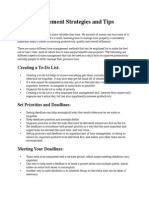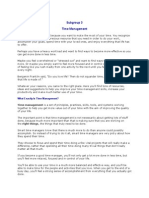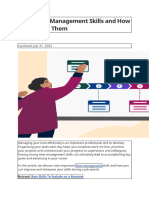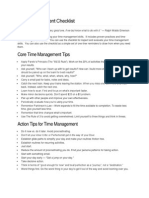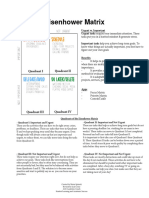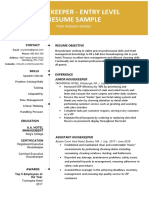Time management
Comprehensive Time Management Guide
1. Understanding Time Management
Time management is the process of planning and exercising conscious control
over the amount of time spent on specific activities to increase effectiveness,
efficiency, and productivity.
2. Assessing Your Current Time Usage
Track Your Time: For one week, track how you spend your time in 15-30
minute intervals.
Analyze Your Data: Identify patterns, time-wasters, and areas where you
are most productive.
3. Setting Goals
SMART Goals: Ensure your goals are Specific, Measurable, Achievable,
Relevant, and Time-bound.
Example: Instead of "read more," set a goal to "read 30 pages of a book
every day."
Short-term vs. Long-term Goals: Break down long-term goals into smaller,
actionable steps.
4. Prioritizing Tasks
Eisenhower Matrix: Categorize tasks into four quadrants:
Urgent and Important: Do these immediately.
Important but Not Urgent: Schedule these tasks.
Urgent but Not Important: Delegate these tasks.
Not Urgent and Not Important: Eliminate these tasks.
ABCDE Method: Label tasks A (most important) to E (least important).
5. Planning Your Time
Daily Planning: Create a to-do list each day, prioritizing tasks based on
importance and urgency.
Time management 1
� Weekly Planning: At the start of the week, outline your main goals and
schedule key tasks.
Monthly/Yearly Planning: Set long-term goals and break them down into
monthly and weekly tasks.
6. Time Management Techniques
Pomodoro Technique: Work for 25 minutes, then take a 5-minute break.
After four cycles, take a longer break (15-30 minutes).
Time Blocking: Allocate specific blocks of time for different tasks or
activities.
Task Batching: Group similar tasks together and complete them in one go.
Eat That Frog: Start your day with the most challenging task.
7. Avoiding Procrastination
Identify Procrastination Triggers: Understand what causes you to
procrastinate (e.g., fear of failure, perfectionism).
Break Tasks into Smaller Steps: Make tasks less daunting by breaking
them into manageable steps.
Set Deadlines: Create a sense of urgency by setting deadlines for tasks.
Use Positive Reinforcement: Reward yourself for completing tasks.
8. Managing Interruptions and Distractions
Create a Distraction-Free Environment: Minimize distractions by creating a
dedicated workspace.
Set Boundaries: Communicate your working hours to family, friends, and
colleagues.
Use Technology Wisely: Turn off non-essential notifications and use apps
that help block distractions.
9. Enhancing Productivity
Leverage Technology: Use apps and tools for time management (e.g.,
Trello, Asana, Google Calendar).
Delegate Tasks: Delegate tasks that others can handle to free up your time
for more important work.
Time management 2
� Learn to Say No: Protect your time by saying no to tasks or activities that
don't align with your goals.
10. Maintaining Work-Life Balance
Schedule Downtime: Ensure you have time for rest and relaxation.
Pursue Hobbies and Interests: Engage in activities that bring you joy and
fulfillment outside of work.
Stay Healthy: Prioritize your physical and mental health through regular
exercise, a balanced diet, and adequate sleep.
11. Reviewing and Adjusting Your Plan
Regular Reviews: At the end of each day/week, review what you've
accomplished and what needs improvement.
Flexibility: Be willing to adjust your plans as needed. Life can be
unpredictable, and it's important to stay adaptable.
Tools and Resources
Time Management Apps: Trello, Asana, Todoist, Google Calendar,
RescueTime.
Books: "Getting Things Done" by David Allen, "The 7 Habits of Highly
Effective People" by Stephen Covey, "Eat That Frog!" by Brian Tracy.
Courses: Time management courses on platforms like Coursera, Udemy,
and LinkedIn Learning.
By following these steps and utilizing the suggested tools and resources, you
can effectively manage your time, increase your productivity, and achieve a
better work-life balance.
Time management 3











